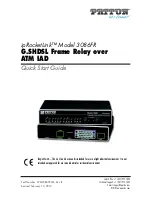
Important:
ICMPv6 plays an important role in IPv6 features such as neighbor discovery, Multicast
Listener Discovery, and path MTU discovery.
Neighbor discovery
IPv6 nodes (routers and hosts) on the same link use neighbor discovery (ND) to discover link
layer addresses and to obtain and advertise various network parameters and reachability
information. ND combines the services for IPv4 with the Address Resolution Protocol (ARP)
and router discovery. ND replaces ARP in IPv6.
Hosts use ND to discover the routers in the network that you can use as the default routers,
and to determine the link layer address of neighbors attached to local links. Routers also use
ND to discover neighbors and link layer information. ND also updates the neighbor database
with valid entries, invalid entries, and entries migrated to various locations.
ND protocol provides you with the following services:
• address and prefix discovery: hosts determine the set of addresses that are on-link for
the given link. Nodes determine which addresses or prefixes are locally reachable or
remote with address and prefix discovery.
• router discovery: hosts discover neighboring routers with router discovery. Hosts establish
neighbors as default packet-forwarding routers.
• parameter discovery: host and routers discover link parameters such as the link MTU or
the hop limit value placed in outgoing packets.
• address autoconfiguration: nodes configure an address for an interface with address
autoconfiguration. See
on page 29.
• duplicate address detection: hosts and nodes determine if an address is assigned to
another router or a host.
• address resolution: hosts determine link layer addresses (MAC for Ethernet) of the local
neighbors (attached on the local network), provided the IP address is known.
• next-hop determination: hosts determine how to forward local or remote traffic with next-
hop determination. The next hop can be a local or remote router.
• neighbor unreachability detection: hosts determine if the neighbor is unreachable, and
address resolution must be performed again to update the database. For neighbors you
use as routers, hosts attempt to forward traffic through alternative default routers.
• redirect: routers inform the host of more efficient routes with redirect messages.
Neighbor discovery uses three components:
• host-router discovery
• host-host communication component
• redirect
Neighbor discovery
Configuration — IPv6 Routing
November 2010 23
Summary of Contents for ERS 8600 series
Page 14: ...New in this release 14 Configuration IPv6 Routing November 2010...
Page 78: ...IPv6 routing configuration 78 Configuration IPv6 Routing November 2010...
Page 132: ...Basic IPv6 configuration using the ACLI 132 Configuration IPv6 Routing November 2010...
Page 176: ...IPv6 routing configuration using the CLI 176 Configuration IPv6 Routing November 2010...
Page 194: ...IPv6 routing configuration using the ACLI 194 Configuration IPv6 Routing November 2010...
Page 206: ...IPv6 DHCP Relay configuration using the CLI 206 Configuration IPv6 Routing November 2010...
Page 238: ...IPv6 VRRP configuration using the CLI 238 Configuration IPv6 Routing November 2010...
Page 250: ...IPv6 VRRP configuration using the ACLI 250 Configuration IPv6 Routing November 2010...
Page 262: ...IPv6 RSMLT configuration using the CLI 262 Configuration IPv6 Routing November 2010...
Page 268: ...IPv6 RSMLT configuration using the ACLI 268 Configuration IPv6 Routing November 2010...
Page 306: ...Multicast protocol configuration using the ACLI 306 Configuration IPv6 Routing November 2010...
Page 344: ...IPv6 traffic filter configuration using the ACLI 344 Configuration IPv6 Routing November 2010...
Page 398: ...CLI show commands 398 Configuration IPv6 Routing November 2010...
















































